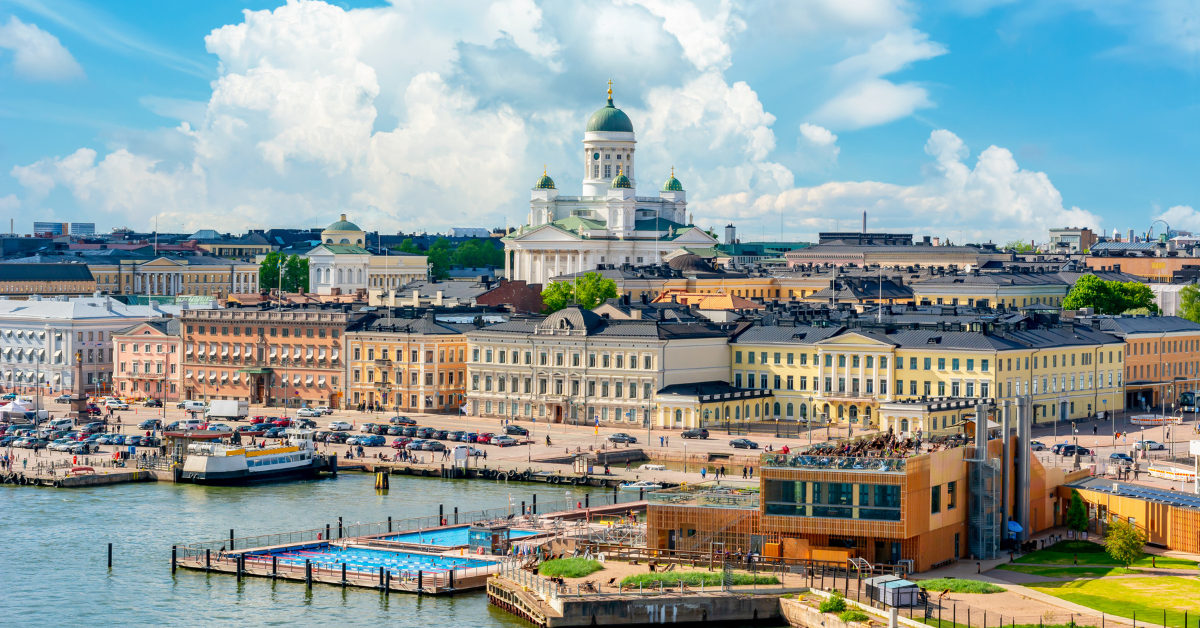The capital of Finland, Helsinki, carries a fascinating linguistic twist. Its Chinese-character form, “赫爾辛基,” represents not only phonetic translation but also a bridge between cultures. While Japanese typically use the Katakana “ヘルシンキ,” this symbolic set of characters reveals the city’s deeper cultural layers. This article explores the essence of Helsinki—from language and design to sports and lifestyle.
The Chinese Character Form “赫爾辛基”
A Transliteration in Chinese
“赫爾辛基 (Hè ěr xīn jī)” is a phonetic transliteration of the Finnish word Helsinki into Chinese characters. The characters are chosen not for their meaning but for their sound similarity. Interestingly, some of the characters have meanings that align with the city’s image:
“赫” means “bright” or “radiant,” “辛” means “new,” and together they evoke the clean, luminous impression of the northern city.
Katakana Is the Norm in Japanese
In Japanese, foreign place names are generally written in Katakana to convey pronunciation naturally. Thus, “ヘルシンキ” is the officially used form in newspapers, maps, and travel guides. While the Chinese-character version may appear intellectual or exotic, it is rarely used in Japan.
How Japanese People Perceive Helsinki
The Center of Nordic Design
For many Japanese, Helsinki is known as the capital of Nordic design. It is the birthplace of world-renowned brands such as Marimekko and Iittala. The city’s design philosophy—simplicity, functionality, and harmony with nature—resonates strongly with Japanese aesthetics.
A City in Harmony with Nature
Helsinki’s greatest charm lies in its perfect balance between city and nature. Just minutes away from the urban center, one can find the sea, forests, and serene parks. Visitors from Japan often describe the city as “clean,” “calm,” and “kind-hearted.”
apanese Perceptions of Helsinki
| Aspect | What Japanese People Feel |
|---|---|
| Design City | Simple, refined, and beautifully functional |
| Rich Nature | Surrounded by sea and forests, peaceful atmosphere |
| Winter Charm | Snow scenes with warm, cozy culture |
| Education Hub | Admired for Finland’s innovative education system |
The Impression of the Characters “赫爾辛基”
A Profound and Exotic Sound
The arrangement of these characters gives a sense of depth and foreign beauty. Though they are used phonetically, the visual appearance of the characters conveys the solemn and tranquil aura often associated with Northern Europe.
Examples of Chinese Transliterations for Place Names
| City | Chinese Form | Pinyin Pronunciation |
|---|---|---|
| Finland | 芬蘭 | Fēn lán |
| Stockholm | 斯德哥爾摩 | Sī dé gē ěr mó |
| Copenhagen | 哥本哈根 | Gē běn hā gēn |
| Helsinki | 赫爾辛基 | Hè ěr xīn jī |
This illustrates how Chinese often uses phonetic transcriptions for place names, focusing on both visual and rhythmic qualities.
The Connection Between Helsinki and Japan
Exchange in Architecture and Design
Japan and Helsinki share a deep cultural connection through design and architecture. Finnish architect Alvar Aalto’s philosophy—creating spaces that are human-centered and inspired by nature—has profoundly influenced Japanese architects. His emphasis on light, wood, and simplicity aligns with Japan’s concept of wa (harmony).
Helsinki as a Popular Tourist Destination
Direct flights between Japan and Helsinki have made the city a convenient gateway to Europe. Compact and walkable, it’s ideal for short stays. In summer, visitors enjoy open-air markets and seaside cafés, while in winter, Christmas markets and sauna culture create a cozy charm.
Seasonal Highlights of Helsinki Tourism
| Season | Main Attractions | Features |
|---|---|---|
| Spring | Parks and harbors | Warmer weather brings new energy |
| Summer | White nights and seaside cafés | Bright and lively atmosphere |
| Autumn | City’s fall colors | Art and design festivals flourish |
| Winter | Christmas markets | Snow scenes and traditional saunas |
Sports Linking Helsinki and Japan
A Historic Olympic City
Helsinki hosted the 1952 Summer Olympics, marking Japan’s first appearance at an international event after World War II. The games symbolized recovery and friendship between Japan and Finland. The performances of Japanese athletes in track, field, and swimming are still remembered with pride.
The Nordic Sports Spirit
In Finland, winter sports are a way of life. Skiing, ice hockey, and skating are common, and outdoor exercise is part of daily culture. The emphasis on health and nature is similar to Japan’s northern regions like Hokkaido and Nagano, where snowy climates foster a similar appreciation for outdoor activities.
Sports and Cultural Parallels
| Field | Helsinki’s Traits | Similarities with Japan |
|---|---|---|
| Olympics | Symbol of postwar rebirth | Like Tokyo, a symbol of hope and recovery |
| Winter Sports | Everyday lifestyle for citizens | Popular in Hokkaido and Nagano |
| Community Sports | Jogging and marathons in public parks | Growing health awareness in cities |
Conclusion
The Chinese-character form “赫爾辛基” is a phonetic transliteration derived from Chinese, while the Katakana “ヘルシンキ” is the standard in Japan. For Japanese people, Helsinki represents a city where design, nature, education, and sports exist in perfect harmony. The 1952 Olympics deepened the connection between the two nations, creating cultural and historical bonds that continue today.
Quiet yet creative, natural yet modern—Helsinki embodies the meaning of “赫,” or “radiant.” Beyond differences in writing, what stands out is the universal charm of Helsinki that transcends language and connects people across borders.






